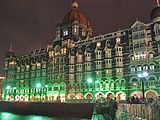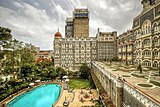Taj Mahal Palace Hotel
This article needs additional citations for verification. (November 2008) |
 Taj Mahal Palace Hotel | |
 | |
| General information | |
|---|---|
| Location | Mumbai, Maharashtra, India |
| Coordinates | 18°55′19″N 72°50′00″E / 18.922028°N 72.833358°E |
| Opening | 16 December 1903 |
| Technical details | |
| Floor count | 7 floors in Taj Mahal Palace, 22 floors in Taj Mahal Tower |
| Design and construction | |
| Architect(s) | Sumit Ballal, Sitaram Khanderao Vaidya and D. N. Mirza |
| Other information | |
| Number of rooms | 560 |
| Number of suites | 44 |
| Number of restaurants | 11 |
| Website | |
| http://www.tajhotels.com/Luxury/Grand-Palaces-And-Iconic-Hotels/The-Taj-Mahal-Palace-Mumbai/Overview.html | |
The Taj Mahal Palace Hotel is a five-star hotel located in the Colaba region of Mumbai, Maharashtra, India, next to the Gateway of India.
Part of the Taj Hotels Resorts and Palaces, this hotel is considered the flagship property of the group and contains 560 rooms and 44 suites. There are some 1,500 staff including 35 butlers. From a historical and architectural point of view, the two buildings that make up the hotel, the Taj Mahal Palace and the Tower are two distinct buildings, built at different times and in different architectural designs.
The hotel has hosted many notable guests, from presidents to captains of industry and stars of show business.[citation needed]
History

The hotel's original building was commissioned by Tata and first opened its doors to guests on 16 December 1903.
It is widely believed that Jamsetji Tata decided to build the hotel after he was refused entry to one of the city's grand hotels of the time, Watson's Hotel, as it was restricted to "whites only". However, this story has been challenged by some commentators that suggest that Tata was unlikely to have been concerned with 'revenge' against his British adversaries. Instead they suggest that the Taj was built at the urging of editor of The Times of India who felt a hotel "worthy of Bombay" was needed.[1]
The original Indian architects were Sitaram Khanderao Vaidya and D. N. Mirza, and the project was completed by an English engineer, W. A. Chambers. The builder was Khansaheb Sorabji Ruttonji Contractor who also designed and built its famous central floating staircase. The cost of construction was £250,000 (£127 million in 2008 prices).[2]
During World War I the hotel was converted into a hospital with 600 beds.[3]
The Taj Mahal Tower, an additional wing of the hotel, was opened in 1973.[4] It was designed by Melton Bekker.[5]
2008 attack

On 26 November 2008, in a series of attacks in Mumbai, the hotel was attacked by Lashkar-e-Taiba, a terrorist group, during which material damage occurred, including the destruction of the hotel's roof in the hours following.[6] Hostages were taken during the attacks, and at least 167 people were killed, including many foreigners. The casualties were mostly Indian citizens, although westerners carrying foreign passports were singled out. Indian commandos killed the gunmen barricaded in the hotel to end the three-day battle. At least 31 died at the Taj. Approximately 450 people were staying in the Taj Mahal Palace and Hotel at the time of the seizure.[7]
Soon after (30 November), Tata chairman Ratan Tata said in an interview with CNN's Fareed Zakaria that they had received advance warning of the attacks and that some countermeasures had been taken. These may have been relaxed before the attack, but in any case were easily sidestepped by the operatives.[8]
The less-damaged sections of the Taj Mahal Palace and Tower hotel reopened on 21 December 2008. It took several months to rebuild the popular heritage section of the Taj Mahal Palace Hotel.[9]
Hillary Clinton visited Mumbai in July 2009, aiming to deepen India – United States relations and stayed at the Taj hotel; she also attended a commemoration event. "I wanted to send a message that I personally and our country is in sympathy and solidarity with the employees and the guests of the Taj who lost their lives ... with the people of Mumbai."[10] On 15 August 2010, India's Independence Day, the Taj Mahal Palace was reopened after restoration. The cost of the restoration of the hotel so far has been 1.75 billion rupees. The palace wing has been restored and offers new hotel services.[clarification needed][11]
On 6 November 2010, U.S. President Barack Obama became the first foreign head of state to stay at the Taj Mahal Palace after the attacks. In a speech from the terrace of the hotel, Obama said that "the Taj has been the symbol of the strength and the resilience of the Indian people."[12]
In media
- William Warren, Jill Gocher (2007). Asia's Legendary Hotels: The Romance of Travel. Singapore: Periplus Editions. ISBN 978-0-7946-0174-4.
- It has also been mentioned in the short story "Sahab Bahadur" by Indian writer Sultan Rashed Mirza, Farhat Ullah Baaaig, and in the novel Delinquent Chacha by Ved Mehta.
- It was portrayed as a dream destination for a schoolboy to visit in the Marathi movie Taryanche Bait.[13]
Hotel Grand Palace is the other name for Hotel Taj Mahal. This name has been used by people as a translation of the Hindi version of Taj Mahal, especially by authors. Such authors as Jeffrey Archer have used this term in their novels.
The hotel was the subject of a four-part BBC Two fly on the wall documentary series starting in August 2014, called Hotel India.[14]
Gallery
-
The Taj Mahal Palace Hotel dome in the old wing.
-
A night view of The Taj Mahal Palace Hotel
-
A view of The Hotel and The Gateway of India from the Arabian Sea.
-
A night view of The Taj Mahal Palace Hotel
-
The Taj Mahal Palace Hotel, west side view
See also
References
- ^ Allen, Charles (3 December 2008). "The Taj Mahal hotel will, as before, survive the threat of destruction". The Guardian. London. Retrieved 24 May 2010.
- ^ Gray, Sadie (27 November 2008). "Terrorists target haunts of wealthy and foreign". The Guardian. London. Retrieved 24 May 2010.
- ^ http://www.vogue.in/content/10-things-know-about-taj-mahal-palace-hotel
- ^ http://www.business-standard.com/article/beyond-business/the-story-of-taj-111121700080_1.html
- ^ http://www.architecturaldigest.com/ad/travel/hotels/2008-09/taj_slideshow_092008
- ^ Ramesh, Randeep (27 November 2008). "Dozens still held hostage in Mumbai after a night of terror attacks". London: The Guardian. Retrieved 28 November 2008.
- ^ "Timeline: Mumbai under attack". BBC News. 1 December 2008. Retrieved 3 December 2008.
- ^ "Taj Mahal Hotel chairman: We had warning". CNN. 29 November 2008. Retrieved 6 September 2013.
- ^ Pasricha, Anjana (21 December 2009). "Mumbai's Attacked Hotels Reopen". Voice of America. Retrieved 22 December 2008.
- ^ Mohammed, Arshad (18 July 2009). "Clinton meets Mumbai victims, serenaded by artisans". Reuters. Mumbai.
- ^ HNN Newswire
- ^ "Obama visits site of Mumbai attacks, praises India's resilience". Los Angeles Times. Retrieved 4 July 2011.
- ^ http://www.timeoutmumbai.net/film/dvd-reviews/taryanche-bait
- ^ Leadbeater, Chris (26 August 2014). "Hotel India: Mumbai's Taj Mahal Palace leaves its darker days behind". The Independent. Retrieved 28 August 2014.











